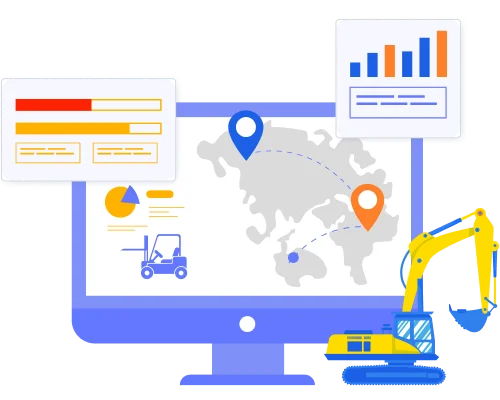
Our client, a global leader in the manufacturing sector specializing in welding consumables and machinery, operates in over 100 countries with a network of more than 30 subsidiaries, delivering exceptional service and support worldwide. To enhance their operations, NeenOpal designed Tableau dashboards currently utilized across four regions and 26 countries, supporting a geographically diverse user base.

To advance their analytical capabilities and foster data-driven decision-making, the client partnered with NeenOpal for the BI project. Their challenges were twofold: limitations in analytical capabilities and restricted data accessibility, both of which hindered their strategic insights.

With NetSuite, the client was able to create linear saved searches and reports that would be sufficient to showcase the situation of a particular department or use-case. However, the requirement was to see a multi-dimensional representation of data that would be able to give insights considering the data across multiple departments/verticals.

The client uses Oracle NetSuite ERP Solution as data repository (and for data presentation). However, the license cost for the same is quite high, limiting the access to a narrow team. Thus, the client wanted a solution that would allow data/dashboard access to a much wider audience with minimal cost implications.
We helped the client with a set of comprehensive dashboards showcasing the data at various cuts, making their processes easier and allowing a better data-driven decision making. The process involved is as follows:
Data is extracted from NetSuite using saved searches or reports, based on the data source. Saved searches are retrieved through a dedicated Restlet API for NetSuite, while reports are delivered via NetSuite's Scheduled Email feature and automated using AWS SES and Amazon WorkMail.
Upon receiving the data in the AWS environment, files are decrypted and stored in Amazon S3. AWS Glue, automated by AWS Lambda, handles data pre-processing and formatting, after which the data is loaded into the Amazon Redshift data warehouse using AWS Glue Triggers. Finally, specific transformations are applied to the base data through SQL Views within the Redshift database.
NeenOpal’s solution integrated data from multiple departments into a centralized repository, enabling Tableau dashboards that provided a unified view of the organization’s performance. This allowed the client to break free from the limitations of isolated NetSuite reports and achieve cross-departmental insights, such as analysing how HR metrics like headcount influenced financial outcomes like EBITDA. Additionally, stakeholders could compare figures from group profit and loss statements with operational data, delivering multi-dimensional insights for improved decision-making and strategic planning.
The final data is consumed by Tableau for dashboarding, connected to the Redshift database
through an Amazon Redshift ODBC connection, ensuring seamless performance for end-users.
Tableau uses an extract connection for optimal performance, with security and access control
managed through role-based user permissions and Row-Level Security (RLS).
Also, by transitioning users who primarily required access to reports from NetSuite licenses
to Tableau licenses, the client achieved significant cost savings. Tableau’s cost-effective
licensing model allowed these users to access all necessary dashboards and reports without
the need for expensive NetSuite licenses, resulting in a 90% reduction in overall licensing
costs. This approach not only expanded access but also optimized resource allocation across
the organization.
NeenOpal delivers full BI solutions with certified AWS and Tableau expertise, offering scalable, cost-effective, and secure analytics. Our custom solutions boost data access, cut costs, and enable data-driven decisions through advanced visualizations. With a focus on security and impactful insights, we give clients a competitive edge in analytics.













A Business Intelligence (BI) roadmap is a plan that guides how to set up and use data analytics tools and processes to gain valuable insights and make informed decisions. It helps organizations build a clear path for integrating data solutions that support long-term growth and success. By aligning technology with business goals, it fosters efficient data management and drives continuous improvement. Learn more.
The implemented solution provided the customer with significant improvements in scalability, cost efficiency, and decision-making capabilities. By integrating advanced automation and robust data visualization, the client achieved greater operational agility and analytical depth.
By leveraging serverless services and trigger-based development within the AWS environment, the backend system provides a highly scalable, automated pipeline. This approach reduces operational overhead and ensures the infrastructure is adaptable to future growth and changes.

Switching from NetSuite to Tableau for data visualization resulted in a significant reduction in licensing and accessibility costs—by approximately 90%, as Tableau licenses are about 20 times more cost-effective than NetSuite’s.

Tableau offers far superior data visualization capabilities, enabling the customer to gain comprehensive, multi-dimensional insights across various business domains. This is a substantial improvement over NetSuite’s limited and narrowly focused visualization tools.

Multi-dimensional data visualizations empower the customer to make more informed decisions by analyzing data from multiple perspectives, integrating insights from departments such as sales, procurement, and inventory.

The implementation of role-based access control (RBAC) allows for precise user segmentation. This ensures that dashboard access is tailored to specific user groups, based on their roles and responsibilities within the enterprise hierarchy, enhancing both security and operational efficiency.

In conclusion, the successful implementation of this comprehensive solution highlights the transformative potential of advanced analytics and sophisticated data processing methodologies. By integrating AWS and Tableau, the solution has become more efficient, scalable, and automated, ensuring long-term sustainability and adaptability. Additionally, adopting Tableau as the dashboarding platform significantly enhances data accessibility and visualization capabilities for a broader audience, all while keeping the cost implications to the minimum compared to the existing NetSuite solution.
